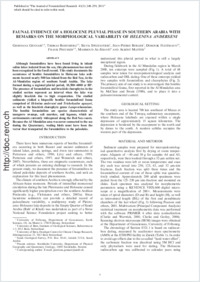Faunal evidence of a holocene pluvial phase in southern Arabia with remarks on the morphological variability of Helenina anderseni
- Gennari, Giordana University of Fribourg, Department of Geosciences, Switzerland
- Rosenberg, Thomas University of Bern, Institute of Geological Sciences, Switzerland - University of Bern, Oeschger Centre for Climate Change Research, Switzerland
- Spezzaferri, Silvia University of Fribourg, Department of Geosciences, Switzerland
- Berger, Jean-Pierre University of Fribourg, Department of Geosciences, Switzerland
- Fleitmann, Dominik University of Bern, Institute of Geological Sciences, Switzerland - University of Bern, Oeschger Centre for Climate Change Research, Switzerland
- Preusser, Frank University of Bern, Institute of Geological Sciences, Switzerland
- Al-Shanti, Mahmoud Saudi Geological Survey, P.O. Box 54141, Jeddah, Saudi Arabia
- Matter, Albert University of Bern, Institute of Geological Sciences, Switzerland
-
04.03.2011
Published in:
- The Journal of Foraminiferal Research. - 2011, vol. 41, no. 3, p. 248-259
English
Although foraminifera have been found living in inland saline lakes isolated from the sea, this phenomenon has rarely been recognized in the fossil record. This study documents the occurrence of benthic foraminifera in Holocene lake sediments located nearly 500 km inland from the Red Sea, in the Al-Mundafan region of southern Saudi Arabia. The lake formed during a regional pluvial period, 10,500–6000 yr BP. The presence of foraminifera and brackish charophytes in the studied section represent an interval when the lake was slightly brackish due to high evaporation. The studied sediments yielded a bispecific benthic foraminiferal fauna comprised of Helenina anderseni and Trichohyalus aguayoi, as well as the brackish charophyte genus Lamprothamnium. The benthic foraminifera are species characteristic of mangrove swamps, salt marshes, and lagoons, which are environments currently widespread along the Red Sea coasts. Because the Al Mundafan area was never connected to the sea during the Quaternary, wading birds must have been the vector that transported the foraminifera to the paleolake.
- Faculty
- Faculté des sciences et de médecine
- Department
- Département de Géosciences
- Language
-
- English
- Classification
- Palaeontology
- License
-
License undefined
- Identifiers
-
- RERO DOC 27026
- DOI 10.2113/gsjfr.41.3.248
- Persistent URL
- https://folia.unifr.ch/unifr/documents/302080
Statistics
Document views: 100
File downloads:
- pdf: 217
